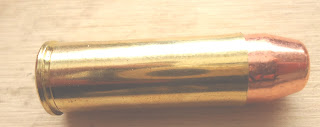Priming and Belling the Cases
After the cases are sized and the primer
removed you are ready to put in a new primer and bell if necessary. Virtually
all straight cases and some bottleneck cases need to be belled or flared. This
allows the bullet to be seated without shaving the case or ruining it. If a
bullet catches the side it will pull part of the case down which will render
that round useless. Lead bullets need to be belled a little more then their jacketed
brethren. It should be flared enough so you can start the bullet in the case
but no more. Excessive belling will shorten the life of the case by causing
cracks at the mouth. If you are using lead bullets in rifles the case needs to
be belled to avoid shaving. Another downside to shaved bullets is loss of
accuracy. One side will be shaved which will cause the bullet to be off
balance.
Properly seated primer
Primers come in two sizes large and small.
Then they are broken down to rifle and handgun. To make things more interesting
there are magnum and standard primers. Let us say that you are loading 9 mm’s
for your Glock. The primer of choice is a small pistol. There are a couple of
reasons for that. First of all the pistol primer has the right amount of
compound to properly but not over ignite your powder charge. Also a rifle
primer is usually taller then the pistol so you will have difficulty properly
seating it. Remember is primer has to be flush with the case head or even a
thousands of an inch or two below to insure good feeding and ignition. While not common a primer that is protruding
can cause a slam fire. That happens when the bolt comes forward and ignites the
round before the action is completely closed. That, my friend will light you up
good and proper. While not common you
can have a residue buildup in your primer pocket. Excess residue will make
seating a primer more difficult but an inexpensive tool can clean them out very
easily. If you hear a crunch when seating a primer, that is a good indication
that the pocket needs cleaning.
Belled case
Depending on what type of set up you have you
can have a primer feed tool or do them one at a time which might not be a bad
way to start. There should be a certain amount of feel but if it is excessive
or too easy there is a problem of some sort. If you have military ammo there is
probably a crimp that has to be removed. For suck cases as a 9 I wouldn’t
bother as it is time consuming. There are tools that will press the crimp but I
never cared for those or you can carefully ream out the pocket. The only cases
I do that with are old 30-06’s that I plan on making blanks or light loads.
Anything else I just scrap. If the primer goes in too easy then the pocket
might be expanded as a result of firing heavy loads in the case. Max loads will
expand the primer pocket sometimes after only one firing. That is a clue to
back off on the powder charge. Shotgun primers generally come in one size
though there is a magnum version. At one time there was a smaller one used but
you seldom encounter them today. Priming
is a simple mechanical chore but not always easy.





No comments:
Post a Comment